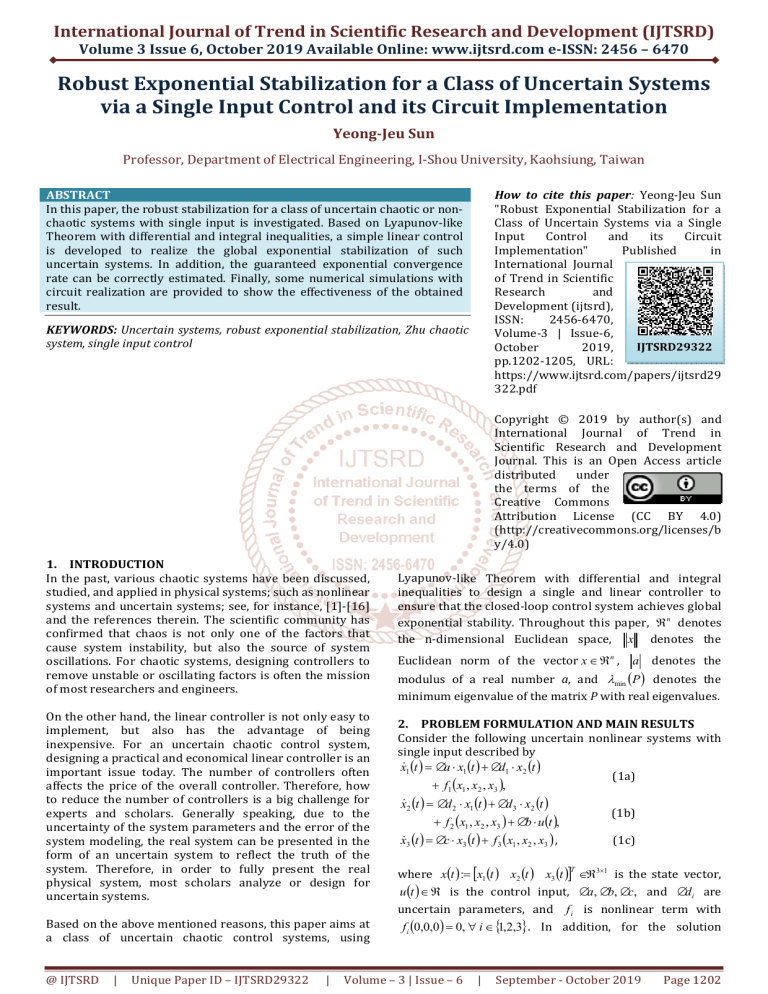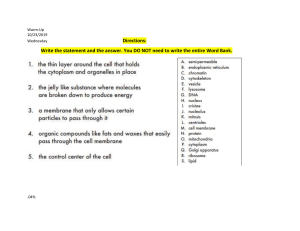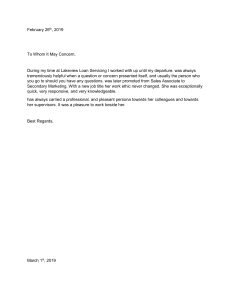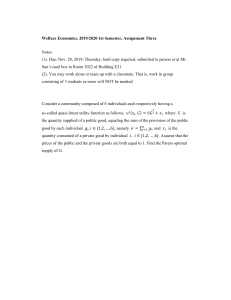
International Journal of Trend in Scientific Research and Development (IJTSRD)
Volume 3 Issue 6, October 2019 Available Online: www.ijtsrd.com e-ISSN:
e
2456 – 6470
Robust Exponential Stabilization for a Class off Uncertain Systems
via a Single Input Control and its
ts Circuit Implementation
Yeong-Jeu Sun
Professor, Department off Electrical Engineering, I-Shou
I Shou University, Kaohsiung, Taiwan
How to cite this paper:
paper Yeong-Jeu Sun
"Robust Exponential Stabilization for a
Class of Uncertain Systems via a Single
Input
Control
and
its
Circuit
Implementation"
Published
in
International Journal
of Trend in Scientific
Research
and
Development (ijtsrd),
ISSN:
2456
2456-6470,
Volume-3
3 | Issue-6,
Issue
IJTSRD29322
October
2019,
pp.1202-1205,
1205, URL:
https://www.ijtsrd.com/papers/ijtsrd29
322.pdf
ABSTRACT
In this paper, the robust stabilization for a class of uncertain chaotic or nonnon
chaotic systems with single input is investigated. Based on Lyapunov-like
Lyapunov
Theorem with differential and integral inequalities, a simple linear control
is developed to realize the global exponential stabilization of such
uncertain systems. In addition, the guaranteed exponential convergence
rate can be correctly estimated. Finally, some numerical simulations with
circuit realization are provided to show the effectiveness
effectivenes of the obtained
result.
KEYWORDS: Uncertain systems, robust exponential stabilization, Zhu chaotic
system, single input control
Copyright © 2019 by author(s) and
International Journal of Trend in
Scientific Research and Development
Journal. This is an Open Access article
distributed
under
the terms of the
Creative Commons
Attribution License
L
(CC BY 4.0)
(http://creativecommons.org/licenses/b
http://creativecommons.org/licenses/b
y/4.0)
1. INTRODUCTION
In the past, various chaotic systems have been discussed,
studied, and applied in physical systems; such as nonlinear
systems and uncertain systems; see, for instance, [1]-[16]
[1]
and the references therein. The scientific community has
confirmed that chaos is not only one of the factors that
cause system instability, but also the source of system
oscillations. For chaotic systems, designing controllers
cont
to
remove unstable or oscillating factors is often the mission
of most researchers and engineers.
On the other hand, the linear controller is not only easy to
implement, but also has the advantage of being
inexpensive. For an uncertain chaotic control
con
system,
designing a practical and economical linear controller is an
important issue today. The number of controllers often
affects the price of the overall controller. Therefore, how
to reduce the number of controllers is a big challenge for
experts and scholars. Generally speaking, due to the
uncertainty of the system parameters and the error of the
system modeling, the real system can be presented in the
form of an uncertain system to reflect the truth of the
system. Therefore, in order to fully present
pre
the real
physical system, most scholars analyze or design for
uncertain systems.
Based on the above mentioned reasons, this paper aims at
a class of uncertain chaotic control systems, using
@ IJTSRD
|
Unique Paper ID – IJTSRD29322
29322
|
Lyapunov-like
like Theorem with differential and integral
inequalities
alities to design a single and linear controller to
ensure that the closed-loop
loop control system achieves global
exponential stability. Throughout this paper, ℜ n denotes
the n-dimensional
dimensional Euclidean space, x denotes the
Euclidean norm of the vector x ∈ ℜ n , a denotes the
modulus of a real number a, and λmin (P ) denotes the
minimum eigenvalue of the matrix P with real eigenvalues.
2. PROBLEM FORMULATION AND MAIN RESULTS
Consider the following uncertain nonlinear systems with
single input described by
x&1 (t ) = ∆a ⋅ x1 (t ) + ∆d1 ⋅ x2 (t )
(1a)
+ f1 (x1 , x2 , x3 ),
x&2 (t ) = ∆d 2 ⋅ x1 (t ) + ∆d 3 ⋅ x2 (t )
(1b)
+ f 2 (x1 , x2 , x3 ) + ∆b ⋅ u (t ),
x&3 (t ) = ∆c ⋅ x3 (t ) + f 3 ( x1 , x2 , x3 ) ,
(1c)
where x(t ) := [x1 (t ) x2 (t ) x3 (t )] ∈ℜ3×1 is the state vector,
u (t ) ∈ ℜ is the control input, ∆a, ∆b, ∆c, and ∆di are
uncertain parameters, and f i is nonlinear term with
T
f i (0,0,0) = 0, ∀ i ∈ {1,2,3} . In addition, for the solution
Volume – 3 | Issue – 6
|
September - October 2019
Page 1202
International Journal of Trend in Scientific Research and Development (IJTSRD) @ www.ijtsrd.com eISSN: 2456-6470
existence of the uncertain nonlinear systems (1), we
assume that f1 , f 2 , and f 3 are smooth functions.
Throughout this paper, the following assumptions are
made:
(A1) There exist constants a , a, b , b, c , c, and di such that
− a ≤ ∆a ≤ − a < 0, 0 < b ≤ ∆b ≤ b ,
−c ≤ ∆c ≤ −c < 0,
3
∑ k ⋅ x ⋅ f (x , x , x ) = 0 .
i =1
i
i
1
2
(
∆d 2 = 0, ∆d 3 = 2.5, f 2 (x1 , x2 , x3 ) = − x1 x3 ,
∆b = 0, ∆c = −4.9, f 3 ( x1 , x2 , x3 ) = x1 x2 .
(
2
≤ V (x(t ))
≤ max{k1 , k 2 , k3 }⋅ x(t ) .
2
(6)
The time derivative of V (x(t )) along the trajectories of
dynamical error system, with (1)-(6) and (A1)-(A2), is
given by
V& (x(t )) = 2k ⋅ x x& + 2k ⋅ x x& + 2k ⋅ x x&
1
− 2k3 cx32
+ 2(k1 x1 f1 + k 2 x2 f 2 + k3 x3 f 3 )
is called the
(
)
≤ −2k1 ax12 + 2 k1 d1 + k2 d 2 x1 x2
+ 2k2 d3 x22 − 2k3 cx32 − 2k2 b rx22
Now we present the main result for the global exponential
stabilization of uncertain nonlinear systems (1) with (A1)
and (A2).
Theorem 1. The uncertain nonlinear system (1) with (A1)
and (A2) is globally exponentially stabilizable at the zero
equilibrium point by the linear control
u = − rx2 ,
(2)
[
= − x1
x2
][
x3 P x1
λmin (P )
≤−
max{k1 , k 2 , k3 }
]
T
V (t ), ∀ t ≥ 0.
Thus, one has
λmin ( P )
t
e max {k1 ,k2 ,k3 } ⋅ V&
(P )
min
t
λmin (P )
+ e max {k1 ,k2 ,k3 } ⋅
⋅V
{k1 , k2 , k3 }
max
λ
λmin ( P )
d max {k1 ,k2 ,k3 }t
e
⋅V
dt
≤ 0, ∀ t ≥ 0.
=
2
.
(3)
with
=e
|
x3
2
It follows that
λmin ( P )
t
d max {k1 ,k2 ,k3 }t
e
⋅ V (x(t )) dt
∫0 dt
@ IJTSRD
x2
≤ −λmin (P ) x(t ) , ∀ t ≥ 0.
Besides, the guaranteed exponential convergence rate is
given by
λmin (P )
,
(4)
2 max {k1 , k 2 , k3 }
)
3 3
+ 2k 2 d 2 x1 x2 + 2k 2 d 3 x22
The objective of this paper is to search a simple linear
control such that the global exponential stabilization of
uncertain nonlinear system (1) can be guaranteed.
Furthermore, an estimate of the exponential convergence
rate of such stable systems is also studied.
(
3
≤ −2k1 ax12 + 2k1 d1 x1 x2
− 2k 2 ∆brx22
In this case, the positive number α
exponential convergence rate.
)
2 2
+ 2k3 x3 (∆cx3 + f 3 )
xi (t ) ≤ k ⋅ e−αt , ∀ t ≥ 0, i ∈ {1,2,3} .
(
2
+ 2k2 x2 (∆d 2 x1 + ∆d3 x2 + f 2 + ∆b ⋅ u )
Definition 1. The system (1) is said to be globally
exponentially stable if there exist a control u and positive
numbers α and k, such that
d
k d +k d
r> 3+ 1 1 2 2
b
4k1k 2 ab
1 1
= 2k1 x1 (∆ax1 + ∆d1 x2 + f1 )
The global exponential stabilization and the exponential
convergence rate of the system (1) are defined as follows.
2k1 a
P := − k1 d1 + k 2 d 2
0
)
)
3
Remark 1. In fact, Zhu chaotic system [16] is a special
case of the uncertain systems (1) with
∆a = −1, ∆d1 = 1.5, f1 (x1 , x2 , x3 ) = x2 x3 ,
with
)
min{k1 , k 2 , k3 }⋅ x(t )
(A2) There exist positive numbers k1 , k2 , and k3 such that
i
(
2k1 a
− k1 d1 + k 2 d 2
det
> 0, and det (P ) > 0 , in
− k d + k d
2
k
b
r
−
d
1
1
2
2
2
3
view of (A1), (A2), and (3). This implies that the matrix of
P is positive definite. Let
(5)
V ( x(t )) := k1 ⋅ x12 (t ) + k2 ⋅ x22 (t ) + k3 ⋅ x32 (t ) .
Obviously, one has
∀ i ∈ {1,2,3}.
∆di ≤ di ,
Proof. It can be readily obtained that det ([2k1 a ]) > 0,
(
− k1 d1 + k 2 d 2
2k 2 b r − d 3
(
)
0
)
0
0 .
2 k3 c
Unique Paper ID – IJTSRD29322
λmin ( P )
t
max {k1 ,k 2 ,k3 }
⋅ V (x(t )) − V (x(0))
t
≤ ∫ 0 dτ = 0, ∀ t ≥ 0.
(7)
0
|
Volume – 3 | Issue – 6
|
September - October 2019
Page 1203
International Journal of Trend in Scientific Research and Development (IJTSRD) @ www.ijtsrd.com eISSN: 2456-6470
From (6) and (7), it is easy to obtain that
2
min{k1 , k 2 , k3 }⋅ x(t )
MOST 107-2221-E-214-030. Furthermore, the author is
grateful to Chair Professor Jer-Guang Hsieh for the useful
comments.
≤ V (x(t ))
−λmin ( P )
REFERENCES
[1] H. Liu, A. Kadir, and J. Liu, “Keyed hash function using
hyper chaotic system with time-varying parameters
perturbation,” IEEE Access, vol. 7, pp. 37211-37219,
2019.
≤ e max {k ,k ,k } V (x(0))
1
2
t
3
−λmin ( P )
≤ e max {k ,k ,k } ⋅ max{k1 , k 2 , k3 }⋅ x(0) , ∀ t ≥ 0.
1
2
t
2
3
Consequently, we conclude that
x(t )
≤
max{k1 , k 2 , k3 }
⋅ x(0) ⋅ e
min{k1 , k 2 , k3 }
−λmin ( P )
t
2 max {k1 ,k 2 ,k3 }
∀ t ≥ 0.
This completes the proof.
[2] Y. Fu, S. Guo, and Z. Yu, “The modulation technology
of chaotic multi-tone and its application in covert
communication system,” IEEE Access, vol. 7, pp.
122289-122301, 2019.
,
□
3. NUMERICAL
SIMULATIONS
WITH
IMPLEMENTATION
Example 1. Consider the system (1) with
−1.2 ≤ ∆a ≤ −0.8, 1 ≤ ∆b ≤ 1.2,
(8a)
CIRCUIT
[4] K. Khettab, S. Ladaci, and Y. Bensafia, “Fuzzy adaptive
control of fractional order chaotic systems with
unknown control gain sign using a fractional order
Nussbaum gain,” IEEE/CAA Journal of Automatica
Sinica, vol. 6, pp. 816-823, 2019.
− 5.2 ≤ ∆c ≤ −4.7, ∆d1 ≤ 1.6, ∆d 2 ≤ 0.2, (8b)
f1 (x1 , x2 , x3 ) = x2 x3 ,
∆d 3 ≤ 2.7,
(8c)
f 2 (x1 , x2 , x3 ) = − x1 x3 , f 3 (x1 , x2 , x3 ) = x1 x2 . (8d)
By selecting the parameters a = 1.2, a = 0.8, b = 1.2, b = 1,
c = 5.2, c = 4.7,
d1 = 1.6,
d 2 = 0.2, d 3 = 2.7, and
k1 = k3 = 1, k 2 = 2, (A1)-(A2) are evidently satisfied.
Thus, one has
(
d 3 k1 d1 + k 2 d 2
+
b
4k1k 2 ab
)
2
= 3.325 .
Consequently, by Theorem 1 with the choice r = 4 , we
conclude that the system (1) with (8) and u = −4x2 , is
globally exponentially stable. In this case, from (4), the
guaranteed exponential convergence rate is given by
λmin (P )
= 0.18 .
2 max {k1 , k2 , k3 }
The typical state trajectories of the uncontrolled system
and the feedback-controlled system are depicted in Fig. 1
and Fig. 2, respectively. Besides, the control signal and the
electronic circuit to realize such a control law are depicted
in Fig. 3 and Fig. 4, respectively.
4. CONCLUSION
In this paper, the robust stabilization for a class of
uncertain nonlinear systems with single input has been
investigated. Based on Lyapunov-like Theorem with
differential and integral inequalities, a simple linear
control has been developed to realize the global
exponential stabilization of such uncertain systems. In
addition, the guaranteed exponential convergence rate can
be correctly estimated. Finally, some numerical
simulations with circuit realization have been provided to
show the effectiveness of the obtained result.
ACKNOWLEDGEMENT
The author thanks the Ministry of Science and Technology
of Republic of China for supporting this work under grant
@ IJTSRD
|
Unique Paper ID – IJTSRD29322
[3] X. Wang, J.H. Park, K. She, S. Zhong, and L. Shi,
“Stabilization of chaotic systems with T-S fuzzy
model and nonuniform sampling: A switched fuzzy
control approach,” IEEE Transactions on Fuzzy
Systems, vol. 27, pp. 1263-1271, 2019.
|
[5] M. Cheng, C. Luo, X. Jiang, L. Deng, M. Zhang, C. Ke, S.
Fu, M. Tang, P. Shum, and D. Liu, “An electrooptic
chaotic system based on a hybrid feedback loop,”
Journal of Lightwave Technology, vol. 36, pp. 42994306, 2018.
[6] S. Shao and M. Chen, “Fractional-order control for a
novel chaotic system without equilibrium,”
IEEE/CAA Journal of Automatica Sinica, vol. 6, pp.
1000-1009, 2019.
[7] N. Gunasekaran and Y.H. Joo, “Stochastic sampleddata controller for T-S fuzzy chaotic systems and its
applications,” IET Control Theory & Applications, vol.
13, pp. 1834-1843, 2019.
[8] H.S. Kim, J.B. Park, and Y.H. Joo, “Fuzzy-model-based
sampled-data chaotic synchronisation under the
input constraints consideration,” IET Control Theory
& Applications, vol. 13, pp. 288-296, 2019.
[9] L. Liu and Q. Liu, “Improved electro-optic chaotic
system with nonlinear electrical coupling,” IET
Optoelectronics, vol. 13, pp. 94-98, 2019.
[10] D. Lasagna, A. Sharma, and J. Meyers, “Periodic
shadowing sensitivity analysis of chaotic systems,”
IET Journal of Computational Physics, vol. 391, pp.
119-141, 2019.
[11] X. Wang, Y. Wang, S. Unar, M. Wang, and W. Shibing,
“A privacy encryption algorithm based on an
improved chaotic system,” Optics and Lasers in
Engineering, vol. 122, pp. 335-346, 2019.
[12] A.G. Carlos Alberto, M.V. Aldo Jonathan, S.T. Juan
Diego, R.G. Gerardo, and M.R. Fernando, “On
predefined-time synchronisation of chaotic systems,”
Chaos, Solitons & Fractals, vol. 122, pp. 172-178,
2019.
[13] V. R. Folifack Signing, J. Kengne, and J.R. Mboupda
Pone, “Antimonotonicity, chaos, quasi-periodicity
and coexistence of hidden attractors in a new simple
Volume – 3 | Issue – 6
|
September - October 2019
Page 1204
International Journal of Trend in Scientific Research and Development (IJTSRD) @ www.ijtsrd.com eISSN: 2456-6470
4-D chaotic system with hyperbolic cosine
nonlinearity,” Chaos, Solitons & Fractals, vol. 118, pp.
187-198, 2019.
1.4
1.2
1
[15] L. P. Nguemkoua Nguenjou, G.H. Kom, J.R. Mboupda
Pone, J. Kengne, and A.B. Tiedeu, “A window of
multistability in Genesio-Tesi chaotic system,
synchronization and application for securing
information,”
AEU-International
Journal
of
Electronics and Communications, vol. 99, pp. 201214, 2019.
0.8
x(t)
[14] M. Alawida, A. Samsudin, J.S. Teh, and R.S.
Alkhawaldeh, “A new hybrid digital chaotic system
with applications in image encryption,” Signal
Processing, vol. 160, pp. 45-58, 2019.
x1
0.6
0.4
0.2
x2
x3
0
-0.2
0
1
2
3
4
5
t (sec)
6
7
8
9
10
Figure 2: Typical state trajectories of the feedbackcontrolled system of Example 1.
[16] S. Vaidyanathan and A.T. Azar, “Global chaos
synchronisation of identical chaotic systems via
novel sliding mode control method and its
application to Zhu system,” International Journal of
Modelling Identification and Control, vol. 23, pp. 92100, 2015.
0
-0.5
-1
u(t)
-1.5
-2
20
x2
x1
15
-2.5
10
-3
5
-3.5
0
x3
1
2
x(t)
0
3
4
5
t (sec)
6
7
8
9
10
Figure 3: Control signal of Example 1.
-5
-10
R2
-15
-20
-25
0
5
10
15
t (sec)
20
25
x2 R1
u
30
Figure 1: Typical state trajectories of the uncontrolled
system of Example 1.
Figure 4: The diagram of implementation of Example
1, where R1 = 10kΩ and R 2 = 40kΩ.
@ IJTSRD
|
Unique Paper ID – IJTSRD29322
|
Volume – 3 | Issue – 6
|
September - October 2019
Page 1205







